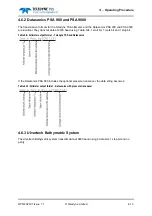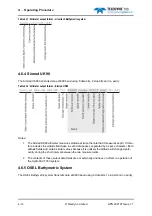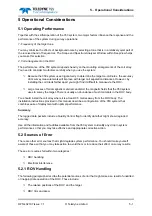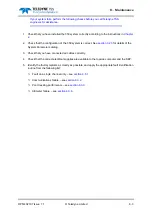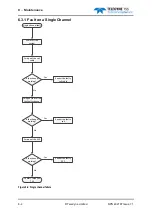
5 – Operational Considerations
5-6
© Teledyne Limited
DPN 402197 Issue 7.1
Summary:
❐
Follow the installation instructions throughout this Manual. Ensure the coil mounting arrange-
ments provide a rigid support that damps vibrations quickly.
❐
Operate the ROV at a speed that avoids the onset of vibration.
❐
Select a tone frequency that does not coincide with the frequency of vibration.
5.2.2.3 Power-carrying cables
If you use the 350 system to survey power cables that carry high currents, the coils might experience
saturation. If this occurs, the system will be unable to calculate the position of the target.
The most effective way to cure this problem is to remove power from the cable or to operate the ROV
at a greater distance from the target.
5.2.2.4 Impressed-current cathodic protection
When surveying near subsea pipes or metallic structures that use impressed-current cathodic
protection, the 350 system might suffer from noise pick-up. Provided the tone frequency is different
from that of the cathodic protection the system will be able to discriminate between the two.
Use the display software to confirm whether such noise breakthrough is occurring.
Summary:
❐
Perform regular checks on signal quality and on the signal-to-noise ratio within DeepView.
❐
If cathodic protection currents present a problem, arrange to switch off the current while you
perform the target survey. The interference will disappear immediately although the protection
afforded by the current will remain for some time afterwards.
5.2.2.5 Operating over ferrous rock dumps
Operating the 350 system over a ferrous rock deposit or dump might affect measurements. This is
because the ferrous content of the rock will introduce a random distortion to the magnetic fields
radiated by the tone-carrying cable.
This distortion varies with the nature of the rock and there is no way to predict the magnitude of errors
introduced.
Summary:
❐
Where possible avoid conducting a survey in areas where the rock formations have a signifi-
cant ferrous content.
❐
Be aware of a possible degradation in measurement accuracy when operating the 350 System
near ferrous rock dumps.
5.2.2.6 Earth return path
If the tone-carrying cable runs parallel with and close to a good conductor, this arrangement might
introduce a shorter earth return path for the tone current. In very severe cases, the shorter return path
might cause errors to appear in measurements made by the 350 system.
In these conditions, the characteristics of the return path are uncertain, making it impossible to predict
the magnitude of errors.






